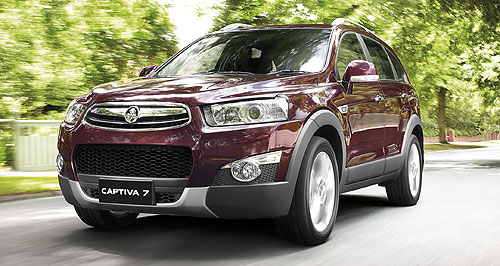New models - Holden - CaptivaHolden improves Captiva fuel economyGimme 5: Sales of the Holden Captiva 5 compact SUV are up 51.8 per cent this year on the back of heavy promotion and driveaway deals. Popular Holden Captiva SUV range now more frugal, seven-seater gets more features6 Jul 2012 HOLDEN has improved the fuel efficiency of all engines across its popular Captiva SUV range by as much as 10 per cent as part of a no-cost upgrade that also brings more standard features to some variants. The improvements come courtesy of “powertrain calibration refinements” to each of the three engines offered across the five-seat Captiva 5 and seven-seat Captiva 7 range, with Holden also giving both petrol options flex-fuel capability, allowing them to run on E85 bio-ethanol as well as unleaded. E85 bio-fuel, which consists of 85 per cent ethanol and 15 per cent petrol, is a cleaner-burning fuel that can reduce carbon dioxide emission by up to 40 per cent over petrol, according to GM Holden figures. Two of the three variants offered in Captiva 7 – a rival for the Toyota Kluger and Ford Territory – have also been handed a longer features list, with the base SX getting rear park assist and the range-topping LX now including heated front seats and front parking sensors. The smaller Captiva 5 – which lines up against the likes of the Mazda CX-5 and Nissan X-Trail – gets no extra features as part of the 2012 update. Unsurprisingly, the biggest fuel savings come on the Australian-made 3.0-litre SIDI (spark ignition, direct injection) V6 shared with the Commodore and offered exclusively on CX and LX versions of the Captiva 7. The 190kW/288Nm unit now consumes 10.1L/100km on the combined cycle, down from 11.3L/100km, an improvement of better than 10 per cent. The smaller 123kW/230Nm 2.4-litre four-cylinder petrol offered on the Captiva 5 and the base SX version of the Captiva 7 now consumes 8.8L/100km in the ‘5’ (down from 9.1) and 9.0L/100km in the ‘7’ (also down from 9.1). The 135kW/400Nm VM Motori 2.2-litre turbo-diesel engine now consumes 7.6L/100km on the front-drive Captiva 7 SX (down from 8.1) and 8.1L/100km on the all-wheel-drive CX and LX (down from 8.3). Despite being smaller, the Captiva 5 retains its higher official consumption with the diesel unit, with the claimed figure now listed as 8.2L/100km (down from 8.5). All Captivas except the base 2.4-litre Captiva 5 come standard with a six-speed automatic transmission. The front-drive Captiva 5 is available with a six-speed manual. All prices remain as before, with Holden currently offering special driveaway deals on both bodystyles. Captiva 5 kicks off at $27,990 on the road and the front-drive SX Captiva is available for $33,990 with no extra charges. Holden executive director of sales, marketing and aftersales John Elsworth said the mild update would further boost sales of the Captiva 5 and 7 range, which are up 51.8 per cent and 2.5 per cent for the year respectively. “We’re constantly looking to improve our products whenever possible, responding to customer feedback and market changes to ensure our vehicles remain highly competitive and relevant to modern Australian families,” he said. Sales of the Captiva 7 trail behind arch-rivals Territory and Kluger to the end of June, with 5157 units compared to 6802 for the Kluger and 7695 for the locally built Territory. Captiva 5 sits well behind compact SUV rivals like the CX-5, X-Trail, Toyota RAV4 and Subaru Forester, with 3139 sales representing a 6.5 per cent share.
 Read moreCaptiva pricing
Motor industry news |
|
||||||||||||||||||||||















Facebook Twitter Instagram